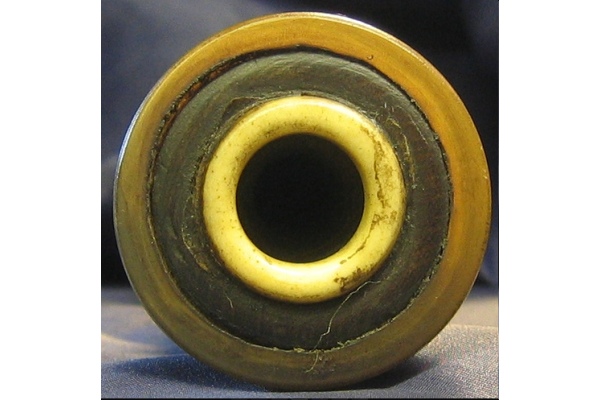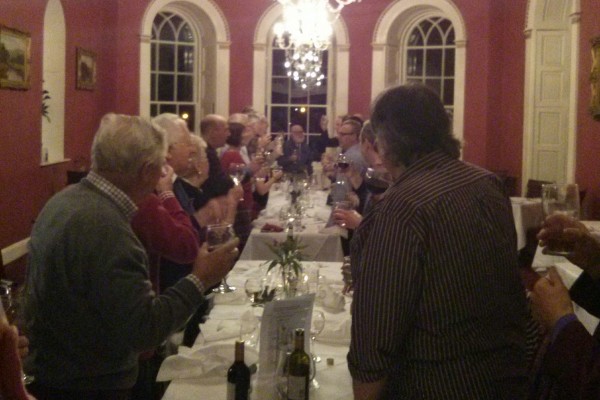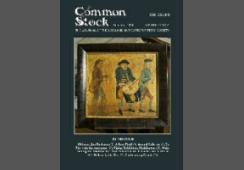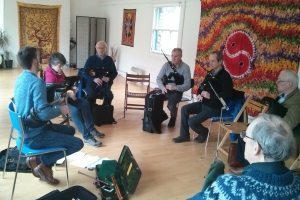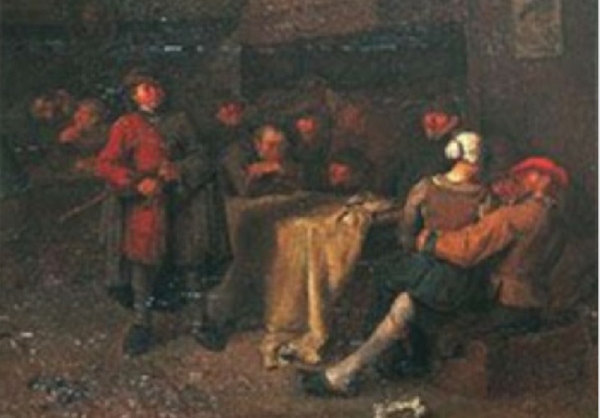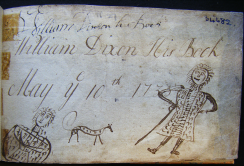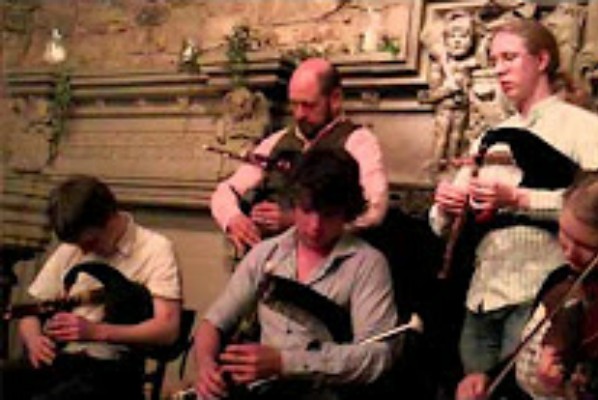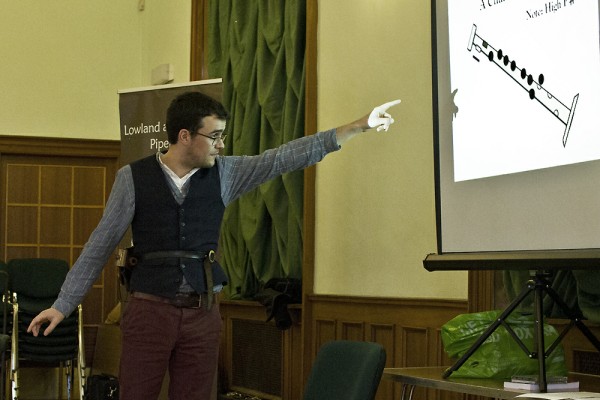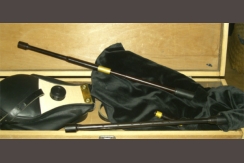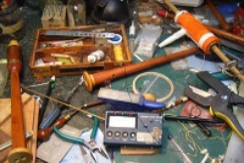


Davie Robertson is a familiar sight (and sound) at the LBPS annual competitions. This talk was illustrated by Davie playing and singing some of his repertoire.
We know from written records that singing to the pipes seems to have been a fairly common practice. It is probably safe to assume that the instrument in question was the sma’ pipe, since it would need the lungs and vocal chords of a bull to compete with the Lowland pipes. It is also probable that these were 18th century drawing-room performances where Italian, French, or polished-up versions of Scots songs might have been accompanied by pastoral pipes, musette or small pipes. However I intend to concentrate on what I understand to be the native tradition.
Since the Scots sma’ pipes seem to have been extinct by the end of last century as a ‘living" musical instrument as opposed to a museum piece or a curiosity, it is stating the obvious to say that as far as we know, no living tradition of playing the sma’ pipes, far less singing to them, has survived to the present day. Thus although we know through the efforts of Gordon Mooney what kind of tunes were played, we can never know with absolute certainty even about such basics as fingering, far less nuances of style, use of ornamentation and so on.
I have a kind of gut feeling about this that makes me tend to agree with Julian Goodacre that in the south of Scotland at any rate, closed fingering would be used Julian explained very lucidly at a Lowland and Border Pipers’ meeting last year just what the technical evidence for this is in the construction of old sets of sma’ pipes, and if you want a resume of this I refer you to him. I have a hunch that when the Northumbrian chanter was stopped, it was not done to achieve a revolutionary new sound, but to improve a sound that was there already - the "popping" staccato sound achievable with closed fingering. It should be remembered however that closed fingering or indeed a stopped chanter does not necessarily preclude the production of a more “Scottish” elemental wail, nor the playing of grace notes nor Highland tunes. Excellent evidence of this can be heard in the playing of the late and unsurpassable Billy Pigg.
It is sometimes forgotten in Northumberland, I suspect, that Jimmy Allen, the famous "Northumbrian" piper at the turn of the 18th Century, was of Yetholm Gypsy stock, and pursued his colourful career on both sides of the Border. This suggests to me that his style of piping was likely to be common to both sides of the Border and that the style from which modern Northumbrian playing derives was as likely to be heard in the 18th Century Morebattle as in Morpeth, in Longformacus as in Longframlington. Perhaps if Billy Pigg had ever sung to the pipes, we would have had a pretty accurate picture of the Border singerpiper’s basic sound.
I think I am right in saying that many of the Lowland pipe tunes researched by Gordon Mooney are the tunes of songs, and it is surely more than likely that these Scots songs heard in "folkie" circles can be played with ease on the sma’ pipes, and I’m sure must often have been sung to sma’-pipe accompaniments.
The most famous songs of the Borders were, of course, the so-called "Border Ballads". I should not of course have to remind you that ballads were meant to be sung, and that ballads were sung not only in the Borders, but throughout the length and breadth of Lowland Scotland. Many ballads lend themselves so readily to pipe accompaniments, that I have no doubt whatever that they must frequently have been sung to the pipes. Luckily, traditional ballad singing has survived to the present day in Scotland, the late Jeannie Robertson being the most famous and probably the most skilled exponent. I like to think that the 18th/early 19th Century singer-piper must have sounded at best like a combination of Billy Pigg and Jeannie Robertson, and at worst something like me.
With my singing and piping I am trying to achieve a sound that I have in my head, which I have imprinted there by a lifetime of listening to authentic traditional singers and musicians. It must also I suppose have been influenced to some extent by Highland piping, Gaelic song, box bands, pop and country-and-western music, and by thirty years of going to folk clubs, although it’s perhaps worth mentioning that much of the rumtie-tum stuff we hear in folk clubs sounds in my humble opinion no more authentically Lowland, than Marjory Kennedy-Fraser’s sounds authentically Gaelic.
Being musically illiterate, and never having been taught piping, I am trying to imitate this sound in my head, blissfully free of the shackles of accepted Highland piping technique, and the dictates of the black dots on a printed page. Unfortunately, being a fairly mediocre musician I continually fall short of my own ideal. I have not yet felt able to do much with the more rollicking rumbustious type of songs, and stick mostly to slow numbers.
Sometimes it is quite effective simply to play a note for note what you’re singing, and if this sounds all right then there’s little need to bother with anything fancier. However, it is possible sometimes to do much more than this. If you are familiar with the singing of such authentic greats as Jeannie Robertson, Lizzie Higgins, Belle Stewart, Jimmy McBeath, and Davie Stuart, you will know that they often use a very free style of singing, and this free style is ideally suited to a sma’-pipe accompaniment. So please forget the horrific modern kailyaird convention that all Scots songs are sung to waltz time, and let’s concentrate on "free-style".
What I do, singing and playing free-style, is carry the basic melody line with my voice, and play a decorated form of it on the pipes. There is really nothing very clever about this. All I’m doing is playing the melody by ear and adding a few twiddly bits now and again, in the same way as Gaelic psalm singers sing slowed-down ornamented forms of well-known metrical psalm tunes, or in much the same way as Lizzie Higgins ornaments basic ballad tunes.
Apparently a primitive accompaniment technique, is to begin your line of accompaniment before you start singing, then mark time a bit on your instrument while your voice catches up with the tune. Conversely you can delay lines or musical phrases on your instrument, then shove them in while your voice carries on with the song. Thus, as I play a verse, I might be anticipating or delaying phrases, and at the same time playing variations on the basic tune by chucking in three or four notes where the basic melody only has one, or perhaps only playing one where the melody has two or three. Also, because of the limita- tions of the pipe chanter, I will sometimes have to play a low note where the tune has a high note, or vice versa, or perhaps play a note that harmonises with the missing one instead of going up or down an octave. Thus although I am really just playing the tune of the song, it sometimes sounds pretty complex, and even on rare occasions like a carefully worked out proper musical accompaniment!
It is of course all done by ear. Any given accompaniment is probably improvised to at least a certain extent, and maybe a little different each time I play it. When I sing to the pipes, it is the song which is important, and the accompaniment is something meant merely to underline and enhance the message of the song. The musical accompaniment therefore should never be intrusive, or distract the listener from the words. If the pipes can enhance the “atmosphere” of the song, well and good. If not, they should simply be a pleasant noise in the background. Fortunately I have a loud voice, and a loud voice can drown out a multitude of fumbles on the chanter.
As far as the singing is concerned, I was unplaced in a recent TMSA competition because the judges were looking for “expression and a certain lightness of touch". Personally I think this is often vastly overdone. It is my belief that a good song or ballad should be able to carry its own message without the aid of quasi operatic shrieks and whispers from the singer. Perhaps more singers should remember that the singer is merely a mouthpiece for something much greater than himself. “Expression” in my humble opinion, can be as intrusive as a whizz-kid accompaniment sounding off with an eruption of musical pyrotechnics. If anything I try to strive for what I believe to be “authenticity”, and I leave "expression" to the purveyors of Kennedy-Fraserisms.
To sum up then, I am trying to sound as I imagine an intelligent 18th Century countryman would have sounded, who was not endowed with musical genius, but loved the heritage and tradition, and found it vibrant and meaningful. I suppose the ultimate aim is to sound as if the tradition had lasted into the twentieth Century and up to the present day, and that I was a part of it and had some small contribution of my own to add to it in carrying it on. That is my idea of authenticity, and if I ever manage to touch on it, I will be more than satisfied.
